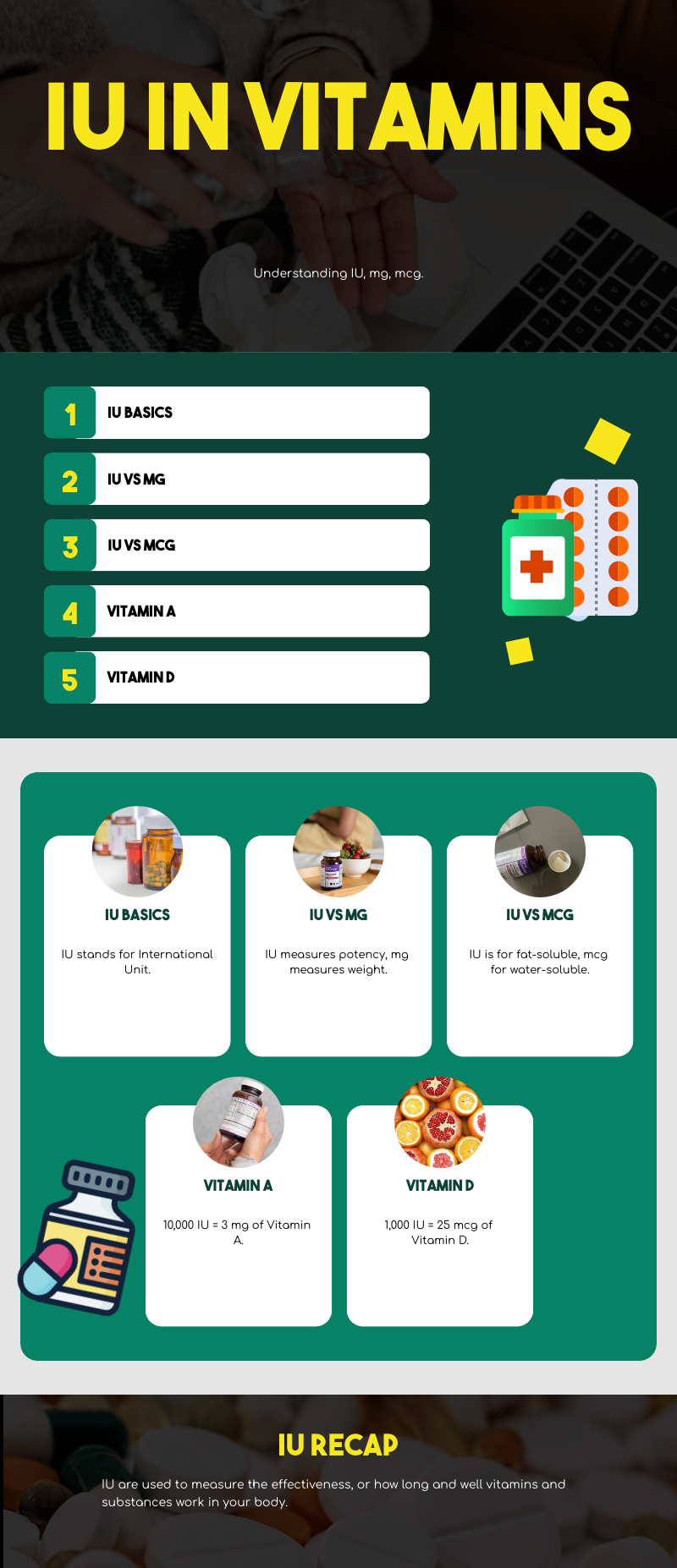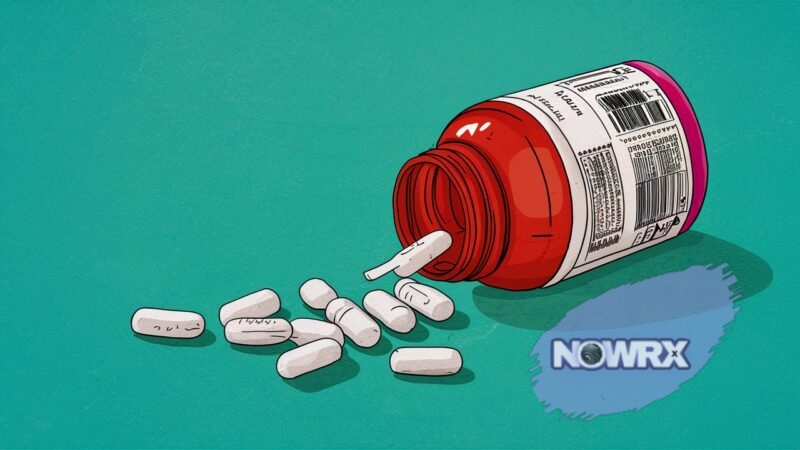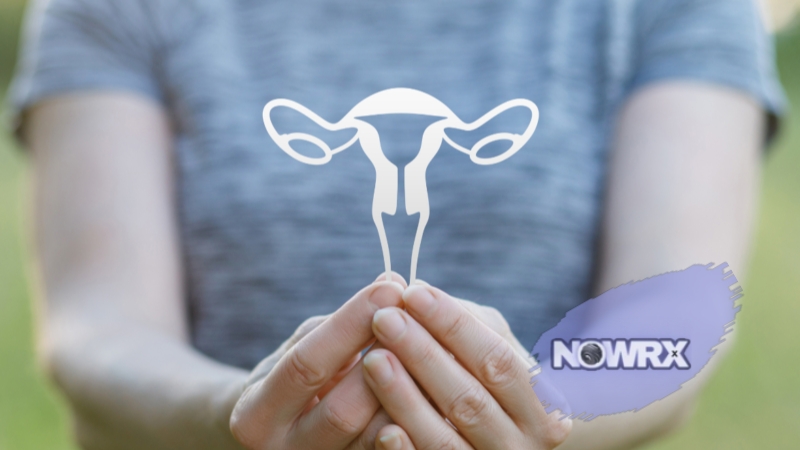You’re in the pharmacy aisle, trying to remember what your doctor said about upping your vitamin intake, but it’s all a bit fuzzy.
Then, you see “IU” on some labels. What’s that about? You’re not a scientist or doctor, so these letters are a mystery.
Should you be looking for more IU, or is less better? And how does it stack up against the “mg” and “mcg” on other bottles?
If these questions are running through your mind in the pharmacy, you’re not alone.
IU isn’t a common measurement outside of health and science fields.
Let’s clear up what IU means on vitamin labels and why it matters in choosing your supplements.

Overview

International Units (IU) are used to measure the effectiveness, or how long and well vitamins and substances work in your body, rather than their weight. This is particularly important for fat-soluble vitamins like A, D, E, and K. Instead of measuring by milligrams (mg) or micrograms (mcg), which tell you about weight, IU measures what a vitamin does in your body.
Take Vitamin D as an example. It comes in different forms, each with its own effectiveness. Weight alone doesn’t give you the full picture of a vitamin’s ability to work in your body, so that’s where IU comes in, offering a way to compare these differences fairly.
The way you convert IU to weight depends on the vitamin:
- For Vitamin A, 1 IU equals 0.3 mcg of retinol or 0.6 mcg of beta-carotene.
- For Vitamin D, 1 IU is the same as 0.025 mcg of cholecalciferol or ergocalciferol.
- For Vitamin E, 1 IU matches 0.67 mg of d-alpha-tocopherol or 0.9 mg of dl-alpha-tocopherol.
Daily Recommended Intakes

- Vitamin A[1]: For toddlers (1-3 years), it’s 300 mcg or 1,000 IU. Adult men (19-64 years) need 900 mcg or 3,000 IU, and adult women need 700 mcg or 2,333 IU.
- Vitamin D[2]: Babies (0-12 months) should get 400 IU. Young adults (19-50 years) need 600 IU, and seniors (71 years and older) need 800 IU.
- Vitamin E[3]: All adults should aim for 15 mg, which is about 22.4 IU.
These numbers come from health experts to ensure we get enough to stay healthy without overdoing it.
When it comes to vitamins, men and women sometimes have different needs:
- Vitamin A: Men usually need about 900 mcg (3,000 IU), while women should get 700 mcg (2,333 IU).
- Vitamin D: Both men and women aged 19-70 should aim for 600 IU, but pregnant and breastfeeding women might need more. It’s best to check with a doctor.
- Vitamin E: Both adult men and women need 15 mg (22.4 IU) for antioxidant protection.
Vitamin Overdose
Here’s what might happen with too much:
- Vitamin A: You could experience issues with your vision, changes in your skin, and even liver damage.
- Vitamin D: This could throw off your calcium levels, make you feel nauseous, and potentially harm your kidneys.
- Vitamin E: Taking too much can increase your risk of bleeding due to its effect on blood clotting.
- Vitamin K: Too much Vitamin K can mess with blood-thinning medications and lead to clotting problems.
Even water-soluble vitamins, which our body usually flushes out in urine, can cause issues in large amounts. For example, too much Vitamin B6 has been linked to nerve damage.
To keep safe and avoid vitamin overdose, here are some guidelines:
- Vitamin A: Adults shouldn’t take more than 10,000 IU per day.
- Vitamin D: It’s recommended to stay under 4,000 IU daily for most adults.
- Vitamin E: Don’t go over 1,000 IU of synthetic Vitamin E.
A case documented in BMJ Case Reports[4] involved a middle-aged male who suffered from vitamin D intoxication and severe hypercalcemia after consuming a daily regimen of 15,000 IU of vitamin D, far exceeding the daily requirement of 400 IU. The patient experienced recurrent vomiting, nausea, abdominal pain, leg cramps, and significant weight loss among other symptoms.
Regulatory Standards for Vitamin IU

The U.S. Food and Drug Administration (FDA) has established regulatory standards for the conversion of IUs to metric units for labeling purposes. This is significant for vitamins like A, D, and E, where the IU represents different quantities for each nutrient based on its biological activity or potency.
For instance, with vitamin A, the IU depends on the source, such as retinol or beta-carotene. According to the National Institutes of Health:
- Vitamin A: 1 IU is the equivalent of 0.3 micrograms (µg) of retinol, or 0.6 µg beta-carotene
- Vitamin D: 1 IU is this same as 0.025 µg cholecalciferol (D3) or ergocalciferol (D2)
- Vitamin E: 1 IU is the equivalent of 0.67 mg of d-alpha-tocopherol or 0.9 mg of dl-alpha-tocopherol
These conversions are crucial to ensure the consistency and accuracy of nutritional labeling, making it easier for consumers to understand the quantity of vitamins they are ingesting and how it contributes to their daily recommended intake. As the industry moves forward, the FDA continues to guide the industry on how to express nutrient content in a way that aligns with these standards.
What Does 5000 UI Means?
5,000 IU represents a measurement of effectiveness, not the quantity by weight or volume that you might expect. The IU, or International Unit, is unique because it measures how effective a vitamin or supplement is, rather than its physical amount.
For example, comparing 5,000 mg of vitamin D3 with 5,000 mg of beta-carotene in terms of their impact on the body doesn’t work because these figures don’t directly relate to their effectiveness. That’s why we use IU to gauge how well each vitamin performs its intended function in the body.
Taking 5,000 IU of Vitamin D3 is often recommended as a daily dose, particularly for women with slightly low levels of vitamin D. However, 5,000 IUs of beta-carotene, which the body converts to vitamin A, could be excessive and potentially increase the risk of fractures.
Bottom Line
With the right guidance and a clear understanding of daily recommendations, you can make sure your vitamins do more good than harm.
Always remember to double-check with healthcare experts to tailor these guidelines to your health profile.
References
- https://www.nhs.uk/conditions/vitamins-and-minerals/vitamin-a/
- https://ods.od.nih.gov/factsheets/VitaminD-Consumer/
- https://ods.od.nih.gov/factsheets/VitaminE-Consumer/
- https://casereports.bmj.com/content/15/7/e250553
Drake Holloway, 45, is a pharmacist and freelance blog writer for NowRx.com. He uses his professional background to provide information and opinions on diverse subjects to those seeking guidance.







